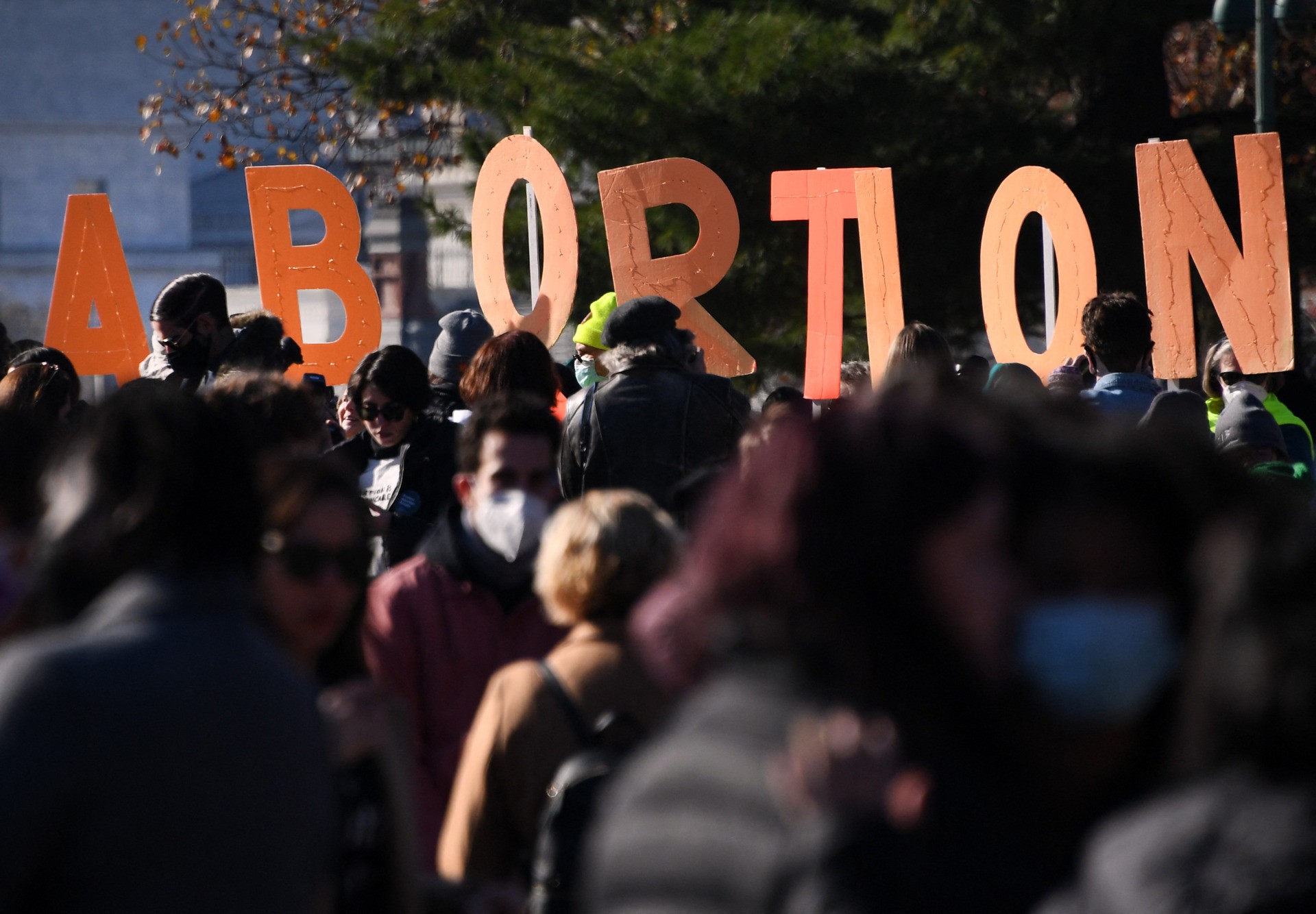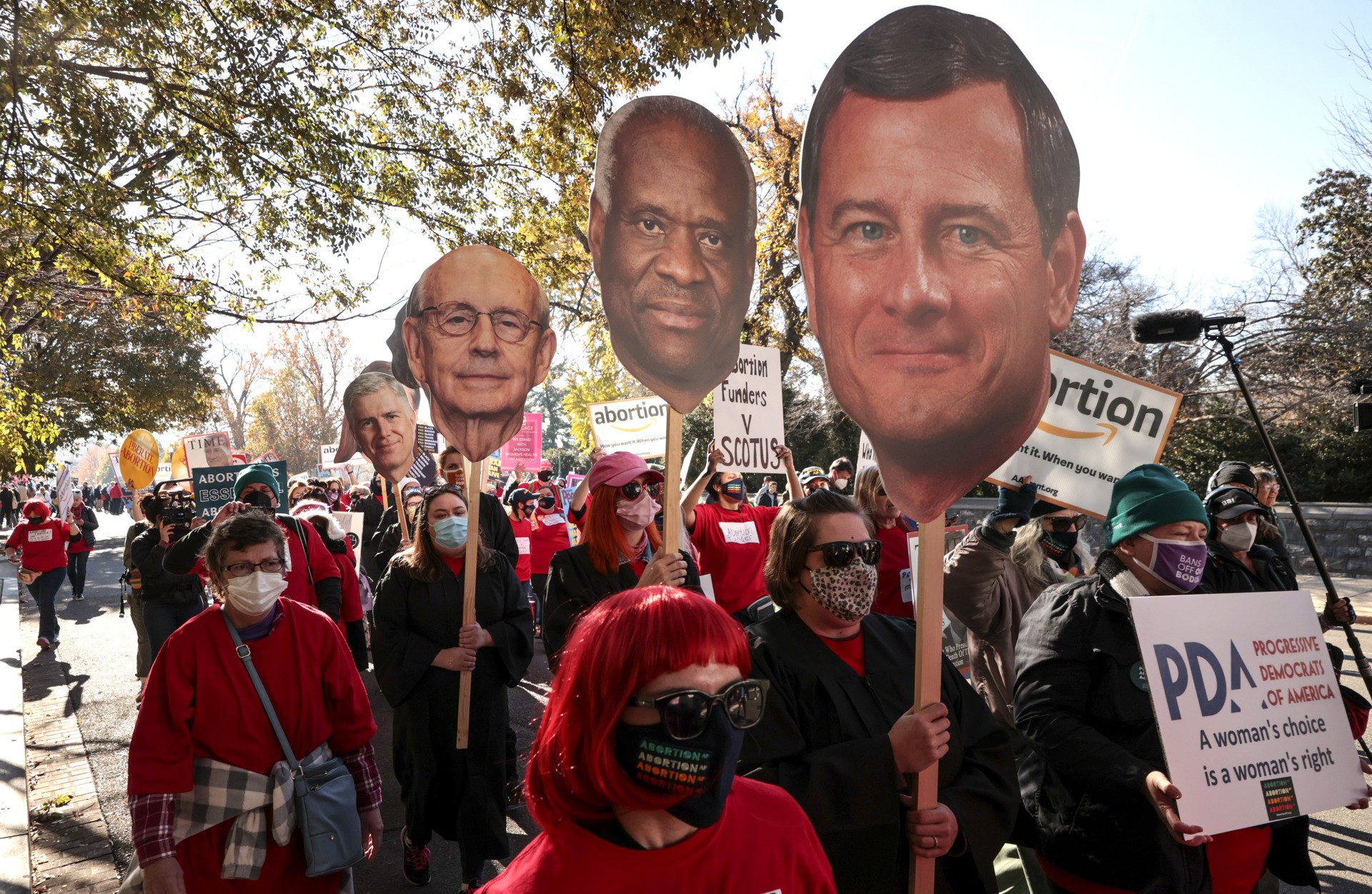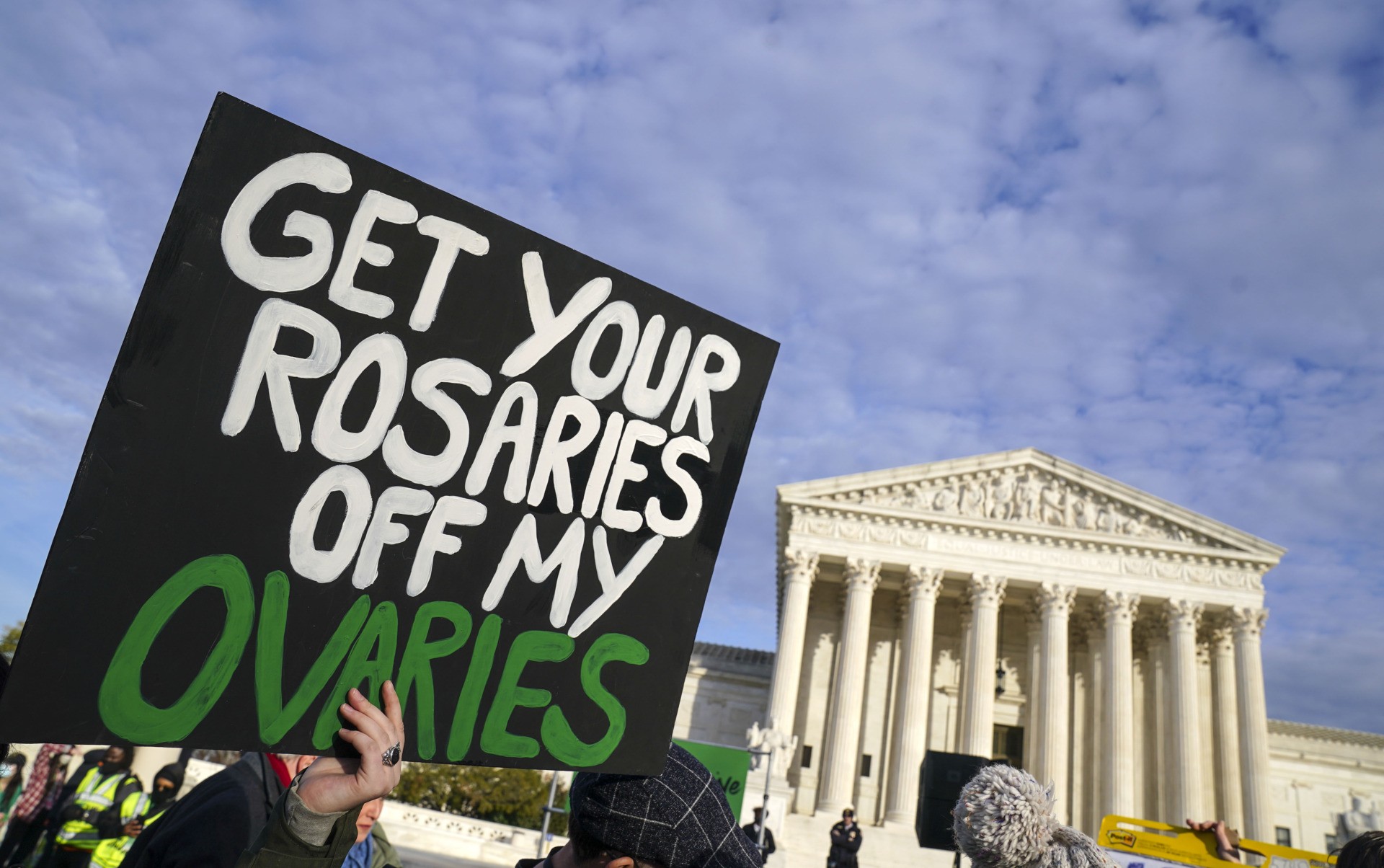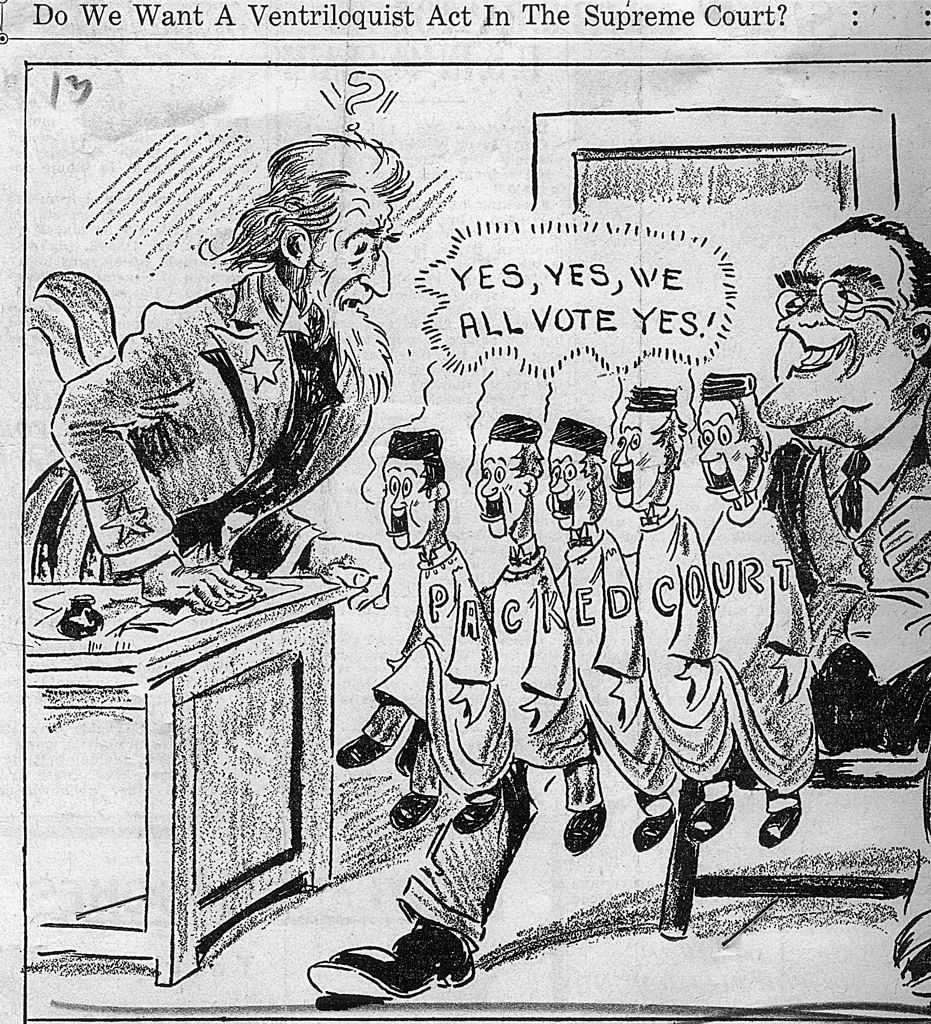Pinkerton: Democrats Use the Threat of Court-Packing to Intimidate the Supreme Court from Overturning Roe
The Democrats’ Court-Packing Threat
Today, we’re getting a real-time lesson in how Washington works. It’s an ongoing drama. We can all observe as the Democrats and their allies in the Main Stream Media seek to intimidate the Supreme Court, trying to scare it away from issuing conservative rulings.
Democrats are saying, in effect, That’s a nice Supreme Court ya got there. Shame if anything were to happen to it.
Needless to say, this is not how our system is supposed to work. According to our Constitution, the judicial branch—of which the Supreme Court is the head—is intended to be an independent and equal branch of the federal government.
As James Madison wrote in Federalist 51—part of a series of pamphlets from 1787-1788 that have shaped our understanding of the Constitution ever since—the essence of our republican system “consists in giving to those who administer each [branch], the necessary constitutional means, and personal motives, to resist encroachments of the others.”
Yet these days, two branches of the federal government, the executive and the legislative—both currently controlled by Democrats—are encroaching hard on the Court, which currently consists of six Republican appointees and three Democratic appointees. This Democratic pressure campaign could succeed because, as we’ll see later on, it’s succeeded before.

Members of the Supreme Court pose for a group photo at the Supreme Court in Washington, DC on April 23, 2021. Seated from left: Associate Justice Samuel Alito, Associate Justice Clarence Thomas, Chief Justice John Roberts, Associate Justice Stephen Breyer and Associate Justice Sonia Sotomayor, Standing from left: Associate Justice Brett Kavanaugh, Associate Justice Elena Kagan, Associate Justice Neil Gorsuch, and Associate Justice Amy Coney Barrett. (Erin Schaff/Getty Images)
The flashpoint issue is abortion.
On December 1, the case of Dobbs v. Jackson Women’s Health Organization was argued before the Court. This is the case that goes right to the heart of the debate over whether or not Roe v. Wade, the 1973 Supreme Court decision that legalized abortion, was rightly decided. Which is to say, for abortion opponents and proponents alike, it’s a big deal.
Pro-abortion liberals are worried that the Dobbs case will go against them. Here’s a sampling of MSM headlines that liberals have been reading: “Roe v. Wade Is Probably Doomed,” “It sure sounds like Roe v. Wade is doomed,” and “Prepare for a post-Roe v. Wade reality.”
Yes, liberals are fearful. And yet they’re also resourceful, and so they’re calling upon their allies, especially within the MSM, to help. Specifically, the mission is to scare the Supreme Court away from voting to limit Roe.
And so isn’t it interesting that on December 3, the Washington Post bannered this headline: “More Democratic senators are willing to weigh changes to Supreme Court.” The article charged right in: “This week’s Supreme Court argument on abortion has accelerated an urgency among Senate Democrats to fundamentally alter how the court operates.”
According to the Post, possible alterations include expanding the roster of the court, which is currently, of course, nine justices. As the article said, “a growing faction” of Democratic senators “say they are now prepared to consider such moves.”
Then, on December 15, Sen. Elizabeth Warren (D-MA) came out for expanding the Court to 13 justices, declaring, “I come to this conclusion because I believe the current Court threatens the democratic foundations of our nation.” Of course, what Warren really means is that she wants a Democratic majority on the Court; the addition of four new justices, appointed by Joe Biden, would turn the current 6:3 conservative majority into a 7:6 liberal majority.
So we can see:The idea of changing the court—which critics call court-packing—is in play. The high Court’s decision on Dobbs probably won’t come till June; and so between now and then, there’s plenty of time for Democrats to hammer their point about packing the Court.

Pro-abortion and pro-life activists demonstrate in front of the U.S. Supreme Court in Washington, DC, on December 1, 2021, as the Court hears oral arguments in the Dobbs v. Jackson Women’s Health case that could potentially overturn the Court’s 1973 Roe v. Wade decision. (OLIVIER DOULIERY/AFP via Getty Images)

Pro-abortion activists hold photos of U.S. Supreme Court justices as they block an intersection during a demonstration in front of the U.S. Supreme Court on December 1, 2021, in Washington, DC, as the Court hears arguments in Dobbs v. Jackson Women’s Health. (Chip Somodevilla/Getty Images)

A pro-abortion activist holds a sign during the Women’s March protest on the steps of the the U.S. Supreme Court on December 1, 2021, in Washington, DC. (Leigh Vogel/Getty Images for Women’s March Inc)
In fact, Democrats have been hammering for a long time, ever since Republicans started putting real conservatives on the Court. For instance, during the 2020 Democratic presidential primary campaign, several of the Democratic hopefuls—including then-Sen. Kamala Harris—declared that they were “open to” the idea of court-packing. Given this hammer-campaign, it’s no surprise that public approval for the Court has fallen sharply.
Notably, as a presidential candidate, Joe Biden said he was opposed to court-packing. However, once in office, on April 9, President Biden created a commission to study the Court, including “the membership and size of the Court.”
To goose things along further, a few days later, on April 15, Democrats in Congress, including Jerrold Nadler, chairman of the House Judiciary Committee, proposed to enlarge the Court to 13 justices. So that would be four new justices picked by Biden, enough to submerge the current 6:3 conservative majority into a 7:6 liberal majority.
In September, White House Principal Deputy Press Secretary Karine Jean-Pierre told reporters that the administration was so concerned about the possible actions of the Court on abortion that the White House Gender Policy Council (which this author had previously written about here) had been tasked to ponder possible presidential options:
And so, on the table, we’re looking at legislative actions—what are the best legislative actions, what are the actions that the administration itself can do. [Biden] wants to see action and remains committed to that.
In other words, “devout Catholic” Joe Biden is going to do all he can to protect abortion, including at least opening the door to the possibility of changing the Court.
In the meantime, other cases piling up before the Court include issues galvanizing to both left and right, such as gun control, affirmative action, and religious education.
Now it should be noted that on December 6, that Biden commission on the Supreme Court came back with no recommendation on court-packing, although it did flirt with other possibilities, such as term limits for justices, such that each president would get at least one appointment. We can call that “court-packing lite.”
Moreover, among the most vocal members of the commission were some who clearly still want to outright pack the Court. For instance, Nancy Gertner of Harvard Law School, was quoted in The New York Times saying of possible changes, “This is a uniquely perilous moment that requires a unique response.” Gertner added, “Whatever the costs of expansion in the short term, I believe, will be more than counterbalanced by the real benefits to judicial independence and to our democracy.”
So we can see: Plenty of Democrats haven’t given up on court-packing.
In the meantime, the MSM drumbeat against the conservative-dominated Court continues. On December 10, CNN legal analyst Jeffrey Toobin said, “The Supreme Court may yet address affirmative action . . . the conservatives have wanted to end affirmative action. Conservatives have wanted to expand the understanding of the Second Amendment to ban most forms of gun control.” Toobin added this warning to fellow liberals: “These are all issues where the Supreme Court appears to be making radical changes in what our understanding of the Constitution means.”
So of necessity, friends of an independent judiciary have had to step up to counter the lefty drumbeat. George Washington University law professor Jonathan Turley, for example, calls Warren’s proposal “perfectly Orwellian.”
Fortunately, too, Constitution-minded Republicans have also joined in the counter-drumbeat. On December 15, Sen. Deb Fischer (R-NE) devoted her weekly column to the danger. As she pointed out, court-packing is a common tactic in dictatorships:
In Venezuela, Hugo Chavez cemented support for his socialist policies by expanding the country’s Supreme Tribunal of Justice from 20 members to 32 back in 2004.
And how’d that work out for Venezuela?

Left-wing activists unfurl a banner in front of the White House calling on President Biden to expand (or pack) the Supreme Court on December 7, 2021, in Washington, DC. (Paul Morigi/Getty Images for Take Back The Court)
Court-Packing: The First Attempt
As it happens, the Democrats have been down this court-packing road before—and in fact, the 85th anniversary is coming up early next year.
Back on February 4, 1937, the 32nd president, Franklin D. Roosevelt, announced his plan for expanding the Supreme Court. Roosevelt was confident he would get his way. He had just been re-elected in a massive landslide, carrying 46 of the 48 states; moreover, the Democrats boasted a 76:16 majority over the Republicans in the Senate, and a 334:88 majority in the House. So FDR had plenty of reason to feel that he was on top of the world.
Yet in his first term, Roosevelt had been frustrated, because the Supreme Court’s conservative majority had invalidated various measures of his New Deal agenda. The most notable of these was the 1935 case of A. L. A. Schechter Poultry Corporation v. United States, in which the Court held the National Industrial Recovery Act, the centerpiece of the New Deal, to be unconstitutional.
So now, in 1937, thumping electoral mandate in hand, FDR thought that he had both the right, and the power, to “fix” the Court by expanding it to as many as 15 justices. As the president said in a nationwide radio address on March 9, 1937:
Last Thursday I described the American form of Government as a three horse team provided by the Constitution to the American people so that their field might be plowed. The three horses are, of course, the three branches of government—the Congress, the Executive and the Courts. Two of the horses are pulling in unison today; the third is not.
So that was FDR’s beef: the Court was not cooperating with the other two federal branches—or put the matter more bluntly, the Court was not doing as the president wished. Of course, as we have seen, the constitutional role of the judiciary is supposed to be independence, not team play. And yet FDR, riding high, thought he knew better.
Bur soon the president’s hubris was laid low. Yes, the country had re-elected FDR as president, but not as dictator. Mindful of Madisonian constitutional principle, critics labeled the White House plan as “court-packing.” The label stuck, and the public opinion erupted.
William Allen White, a prominent newspaper editorialist, wrote that for the first time, opposition to Roosevelt was coming “not from the plug hat [top hat] section but from the grass roots.” And a sympathetic political biographer, James McGregor Burns, wrote in his 1956 book, Roosevelt: The Lion and the Fox, “The proposal at the outset split the American people neatly in half [it was] disturbing to people who wanted law and order.”
Republicans immediately declared their opposition to the court-packing plan. Yet given the lopsided Democratic majorities in the 75th Congress, it didn’t much matter what GOP lawmakers thought. But what did matter was the opposition of many Democratic lawmakers, like, for example, Sen. Carter Glass of Virginia, who said the plan was “completely destitute of all moral understanding.”
Crucially, the Democratic chairs of the Senate and House Judiciary Committees, Sen. Henry Ashurst of Arizona and Rep. Hatton Sumners of Texas, were opposed.
Meanwhile, FDR’s vice president, John Nance Garner, a former speaker of the house who, as vice president, served as president of the Senate, chose to move back to Texas rather than help the administration in its legislative fight.
Indeed, the dean of the liberal bloc on the Supreme Court, Justice Louis Brandeis, made known his opposition.
Confronted with this opposing buzzsaw, the court-packing plan faltered. By August of 1937, it was a dead letter and an embarrassing defeat for the president.

This February 6, 1937, editorial cartoon depicts President Franklin D. Roosevelt and the Supreme Court. (AP Photo)

Editorial cartoon with the caption “Do We Want A Ventriloquist Act In The Supreme Court?” The cartoon, a criticism of President Franklin D. Roosevelt’s New Deal, depicts the president with six new judges likely to be FDR puppets. February 14, 1937. (Fotosearch/Getty Images).
Winning by Losing
Yet here’s the thing: Although Roosevelt’s court-packing plan failed as a matter of legislation, it succeeded in throwing a scare into the Court. Thus the same Court that had regularly voted against the constitutionality of New Deal legislation in Roosevelt’s first term now flipped and routinely affirmed its constitutionality in his second term.
In the words of legal historian Laura Kalman, “The Court dramatically changed course during the ‘constitutional revolution of 1937’ because of the threat posed by the 1936 election and/or the court-packing plan.” And she quoted another historian, William Leuchtenberg, adding that Chief Justice Charles Evans Hughes (1862-1948), a former Republican governor and presidential nominee, was “a very adroit politician and also a man with a sense of the need to preserve the integrity of the Court as an institution.” And so Hughes made “a strategic retreat . . . largely in response to the court-packing plan.” The result was the Court’s “astonishing about-face.”
Thus in April 1937, when it was still unclear whether or not FDR’s court-packing case would succeed, the Supreme Court, in the case of National Labor Relations Board v. Jones & Laughlin Steel Corporation, affirmed the National Labor Relations Act. This, case, concerning economic regulation and worker rights, was a near-total reversal of the Court’s opinion on the Schechter case, from just two years earlier.
An oft-heard quip, first uttered by Oklahoma humorist Cal Tinney, was that the Court had made “The switch in time that saved nine.” (That was a play on the folk saying, “A stitch in time saves nine.”) And so, in the words of law professor John Q. Barrett, FDR “’lost the battle’ but nonetheless ‘won the war’ against the Supreme Court.”
So if we skip back to the present day, what will happen now? Will today’s Court bend, once again, in the face of Democratic pressure? Chief Justice John Roberts, to name the most important of the nine, has proven himself to be the most “political,” that is, the most mindful of political threats to the Court’s reputation and power. After all, the Court is acutely aware that it has no enforcement power in and of itself; the other two branches must agree to bound by its decisions. And so if the Democrats say that the Court is getting out of line, well, maybe in Roberts’ mind the Democrats have to be listened to. In fact, Roberts may already be bending a little. Let’s never kid ourselves: pressure campaigns in work.
So what to do? Sen. Fischer and Sen. Marco Rubio (R-FL) have a good idea: Let’s enact a constitutional amendment to fix forever the number of justices on the Court at nine. That would eliminate the possibility of court-packing, and further enshrine James Madison’s vision of a separate and distinct judicial branch.





Comments are closed.